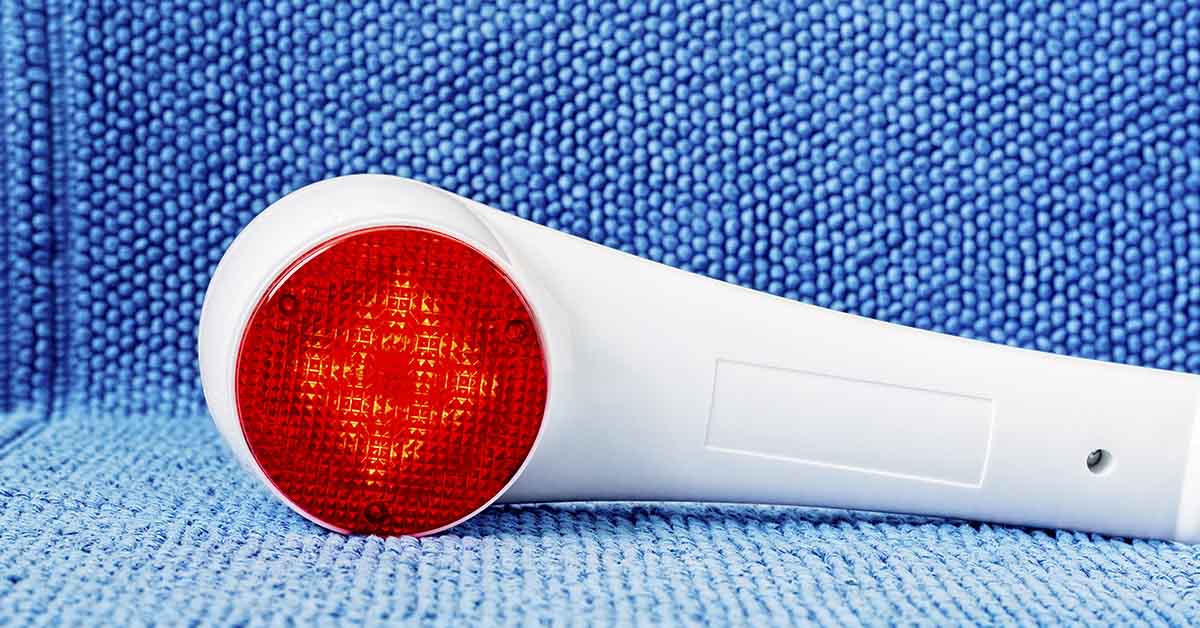Red light therapy and near-infrared light therapy are both treatments that use light to promote healing. Red light is a form of visible light, while near-infrared is a non-visible type of light. Both types of light have been shown to improve circulation and help with pain relief.
What Is Red Light Therapy?
Red light therapy is used to treat pain and inflammation, stimulate the immune system, relieve stress, improve sleep quality, and reduce acne. It also has anti aging properties because it encourages collagen production in the skin by boosting the activity of fibroblasts—the cells that produce collagen—and increasing blood flow to skin cells. (1)
The most common form of red light therapy uses LED lamps that emit red light in the 600- to 900-nm range. This is the same wavelength as a laser, but it’s emitted through an entire spectrum of colors, including infrared and visible light. Red light therapy has a number of benefits, but it’s different from other forms of light therapy. For example, while UVA and UVB rays can be used to treat psoriasis and eczema, red light therapy isn’t effective for these diseases. (2)
How Does Red Light Therapy Work?
The mechanisms behind red light therapy are not well understood, but researchers believe that it works by stimulating certain cells called photoreceptors (also known as photosensors) in the body’s cells. These photoreceptors absorb energy from red light and use it to produce ATP (adenosine triphosphate). This is an important molecule in cells because it provides energy for many life processes, such as muscle contraction or nerve signaling. When there’s not enough ATP available in our bodies for these processes due to injury or disease (such as fibromyalgia or chronic fatigue syndrome), then we feel tired and weak. (3)
Red light therapy has been shown to increase ATP levels in cells, which helps the body’s cells work better and feel less fatigued. The use of red light therapy for fatigue has been studied in a number of conditions, such as chronic fatigue syndrome (CFS), fibromyalgia, muscle damage, and certain types of cancer. In one study, researchers found that red light treatment helped reduce fatigue and pain in people with CFS. Red light therapy also appears to speed up recovery from muscle injuries by reducing inflammation and increasing blood flow to affected areas.
What Types of Red Light Therapy are There?
There are two main types of red light therapy: therapeutic and cosmetic. Cosmetic treatments use low-level lasers that aren’t strong enough to penetrate the skin and reach your cells, so they’re not considered true red light therapy. Therapeutic treatments use red light at a wavelength of 650 nanometers (nm) to penetrate 1 to 2 millimeters into your skin. At this depth, the light penetrates into connective tissue and affects blood flow and the immune system.
The most common type of therapeutic red light treatment is called Low Level Laser Therapy (LLLT). LLLT uses a low-power laser to penetrate the skin and stimulate cells. The therapy increases blood flow, which helps your body heal itself.
Are There Risks of Red Light Therapy?
There aren’t many risks associated with red light therapy. Some people may experience a slight burning sensation or irritation after treatment, which usually goes away after a few minutes. If you have sensitive skin, talk to your doctor before undergoing any type of laser treatment. If you have a medical condition or are pregnant, check with your doctor before undergoing red light therapy. The treatment may not be suitable if you have a pacemaker or other implanted medical device.
The Bottom Line
Red light therapy and Near-infrared light therapy may help with many healthy and beauty-related concerns – from wrinkles to chronic pain. While you can purchase at-home red light therapy masks and machines for cosmetic purposes, always check the efficacy of these products first and speak to your doctor or dermatologist. As is with most cosmetic and therapeutic treatments, they are usually safest when done by a professional.
Keep Reading: 10 Signs You’re Living With Clogged Arteries
Sources
- “6 Potential Health Benefits of Red Light Therapy.” Everyday Health. Jessica Migala. October 14, 2022.
- “What Is Red Light Therapy? A Detailed Beginner’s Guide.” Everyday Health. Jessica Migala. October 14, 2022
- “Red Light Therapy Benefits.” Healthline. Jacquelyn Cafasso. February 23, 2023.
Disclaimer: This information is not intended to be a substitute for professional medical advice, diagnosis or treatment and is for information only. Always seek the advice of your physician or another qualified health provider with any questions about your medical condition and/or current medication. Do not disregard professional medical advice or delay seeking advice or treatment because of something you have read here.

